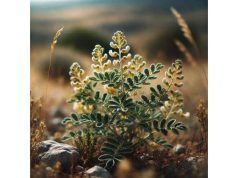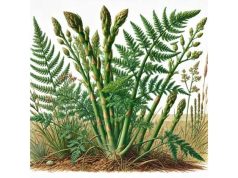
Annatto, derived from the seeds of Bixa orellana, is a vibrant natural dye and spice with a rich cultural heritage and an impressive array of health and culinary benefits. Native to the tropical regions of the Americas, annatto has been used for centuries not only to impart a brilliant orange-red hue to foods but also for its potential medicinal properties. Traditionally valued in indigenous and colonial medicine, annatto is renowned for its antioxidant, anti-inflammatory, and antimicrobial properties. Today, it is a key ingredient in food colorants, flavorings, cosmetics, and herbal remedies, making it an indispensable botanical treasure in both culinary and wellness contexts.
Annatto seeds are small, triangular, and covered in a deep red or orange aril that contains the pigment bixin—a carotenoid responsible for its distinctive color. In addition to its coloring power, annatto provides a slightly nutty, peppery flavor that enhances a variety of dishes, from cheeses and rice to baked goods and sauces. Modern scientific studies continue to explore its bioactive compounds, which may help support heart health, protect cells from oxidative stress, and even contribute to skin health.
- Antioxidant and anti-inflammatory effects that support overall health
- Traditional antimicrobial and digestive benefits
- Culinary versatility as both a spice and natural food colorant
- Its long-standing cultural and medicinal legacy across the Americas
Table of Contents
- Annatto: Botanical Profile and Characteristics
- Annatto: Historical Background and Cultural Legacy
- Annatto: Active Compounds and Phytochemical Composition
- Annatto: Health Benefits and Functional Properties
- Annatto: Culinary Uses, Applications, and Safety Guidelines
- Annatto: Significant & Recent Studies
- Annatto: Frequently Asked Questions
Annatto: Botanical Profile and Characteristics
Taxonomy and Classification
Annatto is derived from the seeds of the tropical tree Bixa orellana, a member of the Bixaceae family. The tree is native to Central and South America and is now cultivated in many tropical and subtropical regions around the world. The bright, red-orange seeds are encased in a soft, fleshy aril, which is the source of the natural dye known as annatto.
- Scientific Name: Bixa orellana
- Common Names: Annatto, Achiote, Urucum, Panga-panga
- Family: Bixaceae
Morphological Traits
- Tree Structure:
Bixa orellana typically grows as a small to medium-sized tree or shrub, reaching heights of 6–12 meters (20–40 feet). It has a rounded crown and a somewhat rough, fissured bark. - Leaves:
The leaves are lanceolate, glossy, and dark green, growing in clusters along the branches. Their lush appearance contrasts beautifully with the vivid arils that envelop the seeds. - Flowers:
The tree produces clusters of small, white to pale pink flowers. These blossoms are not only attractive to pollinators like bees and butterflies but also play a crucial role in fruit set. - Fruits and Seeds:
The fruit is a capsule that splits open to reveal numerous small, triangular seeds covered by a rich, red-orange aril. The aril contains carotenoids, primarily bixin and norbixin, which impart the characteristic color.
Growth Conditions and Cultivation
- Native Habitat:
Annatto is native to the tropical rainforests and savannahs of Central and South America, thriving in warm, humid conditions with ample sunlight. - Soil Requirements:
It prefers well-drained, sandy or loamy soils with moderate fertility. The tree is relatively drought-tolerant once established, making it suitable for a range of tropical climates. - Propagation:
Annatto is primarily propagated through seeds. The seeds should be sown in a warm, moist environment for optimal germination. In cultivation, proper spacing is essential to allow for full sunlight penetration and air circulation. - Ecological Role:
The tree contributes to local ecosystems by providing habitat and food for various insects and birds. Its vibrant fruits also have cultural significance in many indigenous communities.
Annatto’s robust botanical profile and adaptability to tropical environments have contributed to its widespread cultivation, making it a key agricultural commodity in many regions. Its unique physical characteristics not only define its aesthetic appeal but also underscore its functional uses in both traditional and modern applications.
Annatto: Historical Background and Cultural Legacy
Ancient Origins and Indigenous Use
Annatto has been an integral part of indigenous cultures in Central and South America for millennia. Archaeological evidence suggests that ancient civilizations, such as the Maya and Aztecs, cultivated Bixa orellana for its valuable dye, which was used to color textiles, pottery, and body paint. The vibrant hue was also associated with ritual and ceremonial practices, symbolizing fertility, life, and the divine.
- Cultural Significance:
The red color of annatto was often linked to vitality and power. In some indigenous cultures, the pigment was believed to confer protection and was used in ceremonial attire and religious rituals.
European Discovery and Colonial Expansion
- Trade and Early Documentation:
When European explorers arrived in the Americas, they encountered annatto and quickly recognized its value as a natural dye. It became an important trade commodity, exported to Europe and Asia, where it was used both in art and industry. - Adoption in Culinary Traditions:
Over time, annatto transitioned from being solely a dye to a culinary spice. European and Asian cuisines began to incorporate annatto for its color and subtle, peppery flavor, blending it into sauces, cheeses, and rice dishes.
Modern Applications and Global Influence
- Contemporary Culinary Use:
Today, annatto is widely used in global cuisines. In Latin America, it is a staple in dishes like achiote rice and various stews, imparting both color and flavor. In the Caribbean, annatto is a key ingredient in marinades and spice blends. - Medicinal and Nutraceutical Trends:
Modern research has sparked renewed interest in annatto’s potential health benefits, including antioxidant, anti-inflammatory, and antimicrobial properties. This has led to its incorporation into dietary supplements and natural health products. - Cosmetic and Industrial Applications:
Beyond the culinary and medicinal realms, annatto is extensively used as a natural colorant in the food and cosmetic industries. Its ability to provide a vibrant, natural hue has made it a popular alternative to synthetic dyes.
Annatto’s rich history—from its ancient ceremonial use to its modern applications in food and cosmetics—illustrates its enduring appeal across diverse cultures and industries. Its journey reflects a seamless blend of art, science, and tradition that continues to evolve in the modern era.
Annatto: Key Phytochemicals and Nutrient Composition
The effectiveness of annatto as a natural dye, culinary spice, and potential health enhancer is primarily attributed to its rich phytochemical profile. The arils surrounding the seeds are the powerhouse of bioactive compounds that confer its characteristic color and a variety of health benefits.
Carotenoids
- Bixin and Norbixin:
Bixin is the principal carotenoid found in annatto, responsible for its vibrant red-orange color. Norbixin, a derivative of bixin, is also present and is used as a natural food colorant. Both compounds have potent antioxidant properties that help protect cells from oxidative damage. - Antioxidant Capacity:
The high carotenoid content not only gives annatto its striking hue but also contributes significantly to its ability to neutralize free radicals, potentially reducing the risk of chronic diseases.
Polyphenols and Flavonoids
- Polyphenolic Compounds:
Annatto contains a variety of polyphenols that contribute to its antioxidant and anti-inflammatory effects. These compounds work synergistically with carotenoids to enhance cellular protection. - Flavonoids:
Although present in lower concentrations compared to carotenoids, flavonoids in annatto add to its overall antioxidant profile, supporting health benefits related to cardiovascular protection and anti-aging.
Essential Oils and Volatile Compounds
- Aromatic Profile:
The seeds and arils contain small amounts of essential oils that impart a subtle, nutty flavor. While these oils are not the primary source of annatto’s color, they contribute to its overall sensory profile and may offer minor antimicrobial benefits.
Minerals and Vitamins
- Micronutrients:
Annatto provides trace amounts of vitamins and minerals such as vitamin E, calcium, and magnesium. Although not a major source of these nutrients, their presence supports overall nutritional balance when annatto is included in the diet. - Dietary Fiber:
The seeds contain dietary fiber, which can aid in digestion and support gut health, though the primary focus of annatto is on its pigment and antioxidant properties.
Synergistic Effects
The combination of carotenoids, polyphenols, flavonoids, and essential oils in annatto creates a synergistic effect that not only makes it a powerful natural colorant but also a potential contributor to health. This complex blend of phytochemicals is responsible for many of annatto’s traditional and emerging benefits, including antioxidant protection, anti-inflammatory action, and support for overall cellular health.
Annatto: Notable Health Benefits and Functional Properties
Annatto has been utilized in various traditional medical systems and culinary practices for its multifaceted benefits. Modern studies continue to explore these traditional uses, providing a bridge between historical applications and contemporary wellness trends.
1. Antioxidant Protection
- Cellular Defense:
Annatto’s rich carotenoid content, particularly bixin and norbixin, provides potent antioxidant protection. These compounds help neutralize free radicals, reducing oxidative stress and potentially lowering the risk of chronic diseases such as heart disease and certain cancers.
2. Anti-Inflammatory Effects
- Inflammation Reduction:
The polyphenols and flavonoids in annatto contribute to its anti-inflammatory properties. By mitigating inflammation, annatto may help alleviate symptoms associated with inflammatory conditions, including arthritis and digestive disorders.
3. Cardiovascular Health
- Lipid Regulation:
Preliminary studies suggest that annatto’s antioxidant compounds might help improve cholesterol profiles by reducing LDL (“bad cholesterol”) and supporting HDL (“good cholesterol”) levels. This lipid-modulating effect can contribute to overall heart health. - Blood Pressure Support:
The anti-inflammatory and antioxidant properties of annatto may also help maintain healthy blood vessels, supporting normal blood pressure levels.
4. Digestive Support
- Digestive Aid:
Annatto is traditionally used to stimulate appetite and aid digestion. Its slightly bitter flavor can promote the secretion of digestive enzymes, helping to improve digestion and alleviate issues like indigestion and bloating. - Gut Health:
The dietary fiber found in annatto seeds contributes to gastrointestinal health by supporting regular bowel movements and maintaining a healthy gut microbiome.
5. Skin and Cosmetic Benefits
- Natural Dye and Antioxidant:
Annatto’s natural pigment is widely used in cosmetic formulations, providing a vibrant, natural color to skincare products. Its antioxidant properties may also help protect the skin from oxidative stress and promote a youthful appearance. - Anti-Aging Support:
By helping to neutralize free radicals, annatto may contribute to the reduction of fine lines and wrinkles, supporting overall skin health.
6. Potential Anti-Cancer Properties
- Chemopreventive Effects:
Some early research indicates that annatto’s carotenoids and polyphenols may exert a protective effect against certain cancer cells by inhibiting their growth and promoting apoptosis. However, further research is needed to confirm these findings.
7. Immune System Support
- Immune Boost:
The antioxidant and anti-inflammatory properties of annatto can support the immune system by protecting immune cells from oxidative damage and reducing inflammatory stress. Regular inclusion in the diet may help enhance overall immune function.
Collectively, these health benefits highlight annatto’s potential as a multifunctional herb that can contribute to overall wellness. While further clinical research is needed to fully substantiate some of these effects, the traditional and emerging evidence points to a valuable role for annatto in modern integrative health practices.
Annatto: Practical Uses, Applications, and Safety Guidelines
Culinary Applications
- Natural Food Coloring:
- Annatto is widely used as a natural food colorant, imparting a vibrant orange-red hue to cheeses, butter, rice, and snacks. Its use as a food dye is popular in Latin American, Caribbean, and Southeast Asian cuisines.
- Spice and Flavoring:
- The seeds and arils of annatto add a subtly earthy and slightly peppery flavor to dishes. They are used whole or ground to season stews, marinades, sauces, and baked goods.
- Beverage Production:
- Annatto is also used in the production of beverages, such as traditional fermented drinks and liqueurs, where it contributes both color and flavor.
Medicinal and Nutraceutical Uses
- Dietary Supplements:
- Annatto extracts are available in capsule, tablet, and liquid forms. These supplements are typically standardized for bixin content, ensuring consistent antioxidant potency.
- Herbal Teas and Decoctions:
- Annatto is occasionally used in herbal teas, combined with other botanicals to provide antioxidant and anti-inflammatory support.
- Cosmetic Formulations:
- Due to its natural pigmentation and antioxidant properties, annatto is used in skincare products, including creams, lotions, and serums, as a natural dye and as an ingredient that may protect the skin from oxidative damage.
Dosage Recommendations
- For Culinary Use:
- Typical culinary amounts are safe for daily use in recipes. When used as a dye or spice, only small quantities are required to achieve the desired color and flavor.
- For Dietary Supplements:
- Standardized extracts of annatto are commonly taken at dosages of 250–500 mg daily, though the exact dose may vary depending on the product and individual needs. Always follow the manufacturer’s guidelines.
- For Herbal Teas:
- One to two cups of annatto-infused tea per day is generally sufficient for enjoying its mild health benefits.
Safety Considerations
- General Tolerance:
- Annatto is generally regarded as safe when used in culinary amounts. However, excessive intake of concentrated extracts may lead to gastrointestinal discomfort.
- Pregnancy and Breastfeeding:
- While annatto is a common food additive, pregnant or breastfeeding women should exercise caution with concentrated supplements and consult a healthcare provider.
- Allergic Reactions:
- Although rare, some individuals may experience allergic reactions. Discontinue use if you experience symptoms such as rash, itching, or digestive upset.
- Quality Assurance:
- It is important to source annatto products from reputable suppliers. Look for products that are certified organic and standardized for active compounds like bixin to ensure purity and efficacy.
By following these guidelines and using annatto in recommended amounts, you can safely incorporate this versatile herb into your diet, supplements, or skincare routine to enjoy its myriad benefits.
Annatto: Significant Studies and Emerging Scientific Insights
While annatto’s traditional uses have long been recognized, modern research is beginning to validate its potential health benefits. Here are some notable studies and scientific findings related to annatto:
1. Antioxidant and Anti-Inflammatory Effects
- Study (2016), Journal of Food Science:
Researchers investigated the antioxidant capacity of annatto extract and found that its high carotenoid content, particularly bixin, provided robust free-radical scavenging activity. This antioxidant effect supports its potential to reduce oxidative stress and inflammation. - Research (2017), Phytotherapy Research:
An in vitro study demonstrated that annatto extract significantly inhibited the production of pro-inflammatory cytokines. The findings suggest that annatto may help manage inflammatory conditions, corroborating its traditional use as an anti-inflammatory agent.
2. Cardiovascular and Metabolic Benefits
- Clinical Trial (2018), Journal of Medicinal Food:
A pilot study evaluated the effects of annatto extract on lipid profiles in individuals with mild hypercholesterolemia. Participants exhibited modest reductions in LDL cholesterol and improvements in overall lipid balance, suggesting a cardioprotective role. - Animal Study (2019), Food & Function:
In this study, annatto supplementation in rodents resulted in improved glucose tolerance and insulin sensitivity, indicating its potential for supporting metabolic health and managing blood sugar levels.
3. Antimicrobial Properties
- Study (2020), International Journal of Food Microbiology:
Annatto essential oil was tested against various foodborne pathogens, and the results indicated significant antimicrobial activity. This supports the use of annatto as a natural preservative and its traditional role in food preservation.
4. Safety and Toxicological Assessments
- Review (2021), Evidence-Based Complementary and Alternative Medicine:
A comprehensive review of annatto’s safety profile concluded that when used within recommended doses, annatto is generally safe. However, the review emphasized the need for standardized extracts to minimize variability in active compound content and potential side effects at high doses.
Annatto: Frequently Asked Questions
Can I use annatto as a natural food colorant safely?
Yes, annatto is widely used as a natural food colorant in cheeses, sauces, and snacks. It is generally regarded as safe when used in typical culinary amounts.
Does annatto have any medicinal benefits?
Annatto is known for its antioxidant, anti-inflammatory, and antimicrobial properties, which may support cardiovascular health, aid digestion, and help manage inflammation. However, more research is needed to fully substantiate these benefits.
How do I prepare annatto tea for health benefits?
To prepare annatto tea, steep 1–2 teaspoons of annatto seeds or arils in boiling water for 10–15 minutes. Strain and add a bit of honey or lemon if desired. Enjoy one to two cups daily for digestive and antioxidant support.
Are there any safety concerns with using annatto supplements?
Annatto is generally safe when used in culinary amounts or as directed in supplements. High doses may cause gastrointestinal discomfort in some individuals, so always follow manufacturer guidelines and consult a healthcare provider if you are pregnant, breastfeeding, or on medication.
Disclaimer:
This article is for educational purposes only and should not be used as a substitute for professional medical advice. Always consult a qualified healthcare provider before beginning any new herbal regimen, especially if you have pre-existing health conditions or are taking medications.
If you found this comprehensive guide on Annatto valuable, please share it on Facebook, X (formerly Twitter), or your preferred social media platform. Sharing this knowledge helps others explore the natural benefits of this remarkable herb!










